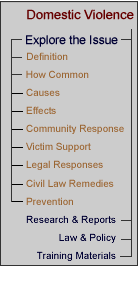|
|
|
9. Prevention Strategies Lobbying and Community Education A strategy for changing the systems (legal, medical, law enforcement, etc.) that undermine women’s safety and batterer accountability may originate from a simple discussion about a common problem. For example, in the United States, the movement to create women's shelters began when small groups of women met to discuss the need for temporary shelter. These groups not only organized shelters, but developed strategies for changing the laws to better meet this need. Women first educated themselves, then sought community support, and eventually approached lawmakers about creating legislation. It was crucial that policymakers were educated about the problem of domestic violence based on the real-life experiences of women. From the identification of a clear need for emergency shelter, women's advocates were able ultimately to achieve the passage of legislation at the state level allocating funds for shelters. Today, over thirty years later, most shelters for battered women and their children in the United States receive a substantial proportion of their funding from state and federal government sources. There are many different approaches to advocacy. Some approaches are grounded in “equality” theory and seek to ensure that battered women are treated the same way that victims of stranger violence are treated. Other approaches recognize that the needs of female victims of domestic violence are sometimes different from the needs of male victims of stranger violence. Lobbying and community education are two possible components of an advocacy strategy. Both can be used effectively by advocates to increase state protection of victims of domestic violence and state efforts to hold batterers accountable. Lobbying can be an effective way to amend laws and introduce new laws needed by women seeking protection from abuse and to ensure that abusers are sanctioned. While community education does not directly address state obligations with respect to domestic violence, it is an excellent way of starting to change public awareness and perceptions of domestic violence. One reason domestic violence continues is that the community at large has not made it unacceptable. People say that domestic violence is wrong, but often look the other way. A public message about violence prevention is an effective way to change behavior. Grassroots support can also increase the leverage that can be brought to bear on politicians and other government officials. The purpose of most criminal justice system interventions for domestic violence is to hold the perpetrator accountable for his actions. These interventions, however, are only a temporary solution to the problem. Even if a perpetrator receives jail time, his victim may not be any safer when he is released and may be at greater risk of harm. The most effective protection against violence is to prevent it from occurring in the first instance. Several batterers intervention programs have been developed in the United States and Western Europe. Organizations in countries in CEE/CIS are also beginning to work with the male perpetrators of domestic violence in batterer’s treatment groups in an effort to influence their future behavior. Like other interventions, a batterers’ treatment group must be based on a specific theory of violence to be effective. The model created by the Duluth Domestic Abuse Intervention Project has been effective in the United States and has been the basis for several new programs being implemented in countries in CEE/CIS. The Duluth model is based on the theory that violence is intentional and is a system of abusive behaviors that batterer uses to maintain control over his wife or intimate partner. Other groups have developed different programs using this same theory of violence. From Guidelines for Men Who Batter Programs. This Duluth model of the treatment group is based on a few guiding principles. First, the groups focus on the safety of the victim and children. Second, the groups work to hold the perpetrator, not the victim, accountable for his abusive behavior and for stopping the abuse. Third, the groups respect the victim’s choices and ability to direct her own life. These groups are not the same as marriage or couples counseling and do not focus on keeping the couple together. Similarly, they are not substance abuse counseling. Treatment for alcohol and drug abuse should be addressed separately. Although some batterers may express regret about their actions, they also received mixed messages from society that may support their abuse of women. A batterers intervention group provides a social network of others who may be support nonviolent behavior. The group format provides men with a variety of models and resources to learn how to interact differently with their partners and change their behavior. Taking part in a group treatment program may also help batterers to decrease their dependence on their partners, and reduce some of the shame that may come from discussing their abusive behaviors for them to be more forthcoming about their actions. Although batterers’ treatment programs often take place in a group counseling setting, individual therapy may also be necessary, or helpful, for many of the men. Procedures Used in Batterers’ Treatment Groups Generally, there are three categories of procedures that are used in batterers’ treatment groups: (a) altering attitudes toward violence and personal responsibility, (b) planning for safety, and (c) learning alternative skills for nonviolence. From Jeffrey Edleson & Richard Tolman, Intervention for Men Who Batter: An Ecological Approach (1992). Men will not change their behavior by participating in the group unless they are willing to change. Men must recognize and acknowledge their abusive behavior and have a full understanding of the effect it has on their partners, their relationships, and themselves. Men must take responsibility for both the physical violence that they inflict on their partners as well as other forms of abuse such as sexual violence, psychological abuse, and economic coercion. Batterers’ treatment group facilitators often confront the men about their negative or sexist attitudes, support for abusive behaviors, and denial of abuse. This confrontation challenges men to take responsibility for the abuse by requiring them to examine their beliefs and actions. In a treatment group, batterers must analyze their behaviors and examine the ways in which they use violence or other abusive tactics to control women. The batterer learns to monitor his actions to understand the feelings he has when he becomes violent, such as anger, inadequacy, jealousy, or the need to control the situation. Group members may have offenders draw the chain of events that lead to the abusive behaviors. Although a batterer may feel angry or upset, he must still take personal responsibility for his actions. His use of violence or other forms of abuse is a personal choice. Learning Alternatives to Abusive Behaviors Batterers’ treatment groups often teach offenders to recognize when they are acting abusively. If necessary, the batterers should temporarily withdraw from a situation of conflict. They should call a hotline or to talk to someone who will support them in not using violence. When the batterer can react in a non-abusive manner, he should return to discuss the problem without using violence or other forms of abuse. As the treatment group continues, batterers should better understand their abusive behavior and develop alternative skills and methods of interacting with their partner that do not involve violence. Although the goal of the batterers’ treatment group is to stop the perpetrators’ abusive behaviors, it is not always successful. Advocates must be realistic about the outcomes to expect from batterers’ treatment groups. Some men who complete the group do change their behavior. When a batterer makes the commitment to change his actions it is important for him to address a few key issues:
Adapted from Paymar, Michael, Violent No More: Helping Men End Domestic Abuse, Hunter House (2000). Assessing the outcome of batterers’ treatment programs has been very difficult. The results vary dramatically depending on whether success is measured by how many men are rearrested or how many of their partners perceived a change in the offender. In Controversies and Recent Studies of Batterer Intervention Program and Effectiveness, Larry Bennett and Oliver Williams compare a number of studies on the effectiveness of batterer intervention programs. While they concluded that none of the programs have shown themselves superior to other approaches, batterers intervention programs generally have had a small but significant effect on the rates of violence. |
| Home | Contact | Feedback | Disclaimer |

